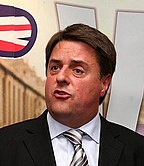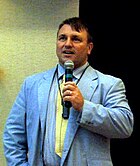Third Position
This article needs additional citations for verification. (January 2008) |
| Part of a series on |
| Neo-fascism |
|---|
 |
|
|
The Third Position is a set of neo-fascist political ideologies that were first described in Western Europe following the Second World War.[1][2][3] Developed in the context of the Cold War, it developed its name through the claim that it represented a third position between the capitalism of the Western Bloc and the communism of the Eastern Bloc.
History
[edit]The term "Third Position" was coined in Europe and the main precursors of Third Position politics were Italian fascism, Legionarism, Falangism, Prussian socialism, National Bolshevism (a synthesis of far-right ultranationalism and far-left Bolshevism) and Strasserism (a radical, mass-action, worker-based form of Nazism, advocated by the "left-wing" of the Nazi Party by brothers Otto and Gregor Strasser, until it was crushed in the Night of the Long Knives in 1934). Neo-fascist, neo-Nazi author Francis Parker Yockey had proposed an alliance between communists and fascists called the red-brown alliance (Red being the color of communism and Brown being the color of Nazism). Yockey lent support to Third World liberation movements as well.
Germany
[edit]Querfront ("cross-front") was the cooperation between conservative revolutionaries in Germany with the far-left during the Weimar Republic of the 1920s.
Ernst Niekisch and others tried to combine communist and anti-capitalist nationalist forces to overthrow the existing order of the Weimar Republic. He called this merger "National Bolshevism". During his early years in Nazi Party as SS-Gauführer, Nazi leader Heinrich Himmler worked briefly as a deputy of Gregor Strasser, then head of party propaganda department. Influenced heavily by Strasserist ideas, Himmler attacked capitalism and viewed socialism as "the natural economic system" during the 1920s.[4] Germany's Chancellor, General Kurt von Schleicher (in office 1932–33), attempted to induce the more left-wing Strasserist segment of the Nazi Party to merge with the trade unions as way of forcing Hitler to support his government, but his plan failed.[5]
The term is also used today for mutual entryism or cooperation between left and right-wing groups. For example, at a Berlin peace rally on February 24, 2023, called by Sahra Wagenknecht, at the time a leading figure of Germany's socialist Left Party, and feminist Alice Schwarzer in support of their manifesto calling for negotiations and stop of military support of Ukraine, far-right factions and pro-Russian supporters were in attendance.[6]
France
[edit]During the 1930s and 1940s, a number of splinter groups from the radical left became associated with radical nationalism. Jacques Doriot's French Popular Party (from the French Communist Party) and Marcel Déat's National Popular Rally (from the French Section of the Workers' International). Third Position ideology gained some support in France, where in 1985 Jean-Gilles Malliarakis set up a "Third Way" political party, Troisième Voie (TV). Considering its main enemies to be the United States, communism and Zionism, the group advocated radical paths to national revolution. Associated for a time with the Groupe Union Défense, TV was generally on poor terms with Front National until 1991, when Malliarakis decided to approach them. As a result, TV fell apart and a radical splinter group under Christian Bouchet, Nouvelle Résistance, adopted National Bolshevik and then Eurasianist views.[7]
Italy
[edit]In Italy, the Third Position was developed by Roberto Fiore, along with Gabriele Adinolfi and Peppe Dimitri, in the tradition of Italian neo-fascism. Third Position's ideology is characterized by a militarist formulation, a palingenetic ultranationalism looking favourably to national liberation movements, support for racial separatism and the adherence to a soldier lifestyle. In order to construct a cultural background for the ideology, Fiore looked to the ruralism of Julius Evola and sought to combine it with the desire for a cultural-spiritual revolution. He adopted some of the positions of the contemporary far-right, notably the ethnopluralism of Alain de Benoist and the Europe-wide appeal associated with such views as the Europe a Nation campaign of Oswald Mosley (amongst others). Fiore was one of the founders of the Terza Posizione movement in 1978. Third Position ideas are now represented in Italy by Forza Nuova, led by Fiore; and by the movement CasaPound, a network of far-right social centres.
United Kingdom
[edit]In the 1980s, the National Front, a British fascist party that had experienced the height of its success in the 1970s, was taken over by a Strasserist faction that referred to themselves as Third Positionist.[8] The Strasserist-led National Front was also characterised by Baker as National Bolshevist in ideology.[9] Reflecting the Nouvelle Droite's influence,[10] the Strasserist Official NF promoted support for "a broad front of racialists of all colours" who were seeking an end to multi-racial society and capitalism,[8] praising black nationalists like Louis Farrakhan and Marcus Garvey.[11] Their publication, Nationalism Today, featured positive articles on the governments of Libya and Iran, presenting them as part of a global anti-capitalist and anti-Marxist third force in international politics;[12] its members openly acknowledged the influence of Libyan leader Muammar Gaddafi and his Third International Theory.[13] This may have had tactical as well as ideological motivations, with Libya and Iran viewed as potential sources of funding.[10] This new rhetoric and ideology alienated much of the party's rank-and-file membership.[14] It experienced internal problems, and in 1989 several of its senior members—Nick Griffin, Derek Holland, and Colin Todd—split from it to establish their International Third Position group.[14] One of its leaders was Roberto Fiore, an ex-member of the Italian far-right movement Terza Posizione.[15]
United States
[edit]In the United States, Political Research Associates argues that Third Position politics has been promoted by some white nationalist and neo-Nazi groups such as the National Alliance, American Front, Traditionalist Worker Party, Patriot Front, and White Aryan Resistance, as well as some black nationalist groups, such as the Nation of Islam, since the late 20th century.[16] In 2010, the American Third Position Party (later renamed American Freedom Party) was founded in part to channel the right-wing populist resentment engendered by the financial crisis of 2007–08 and the policies of the Obama administration.[17]
See also
[edit]- Anti-corporate activism
- Corporatism – Political ideology which advocates the organization of society by corporate groups
- Eurasianism – Socio-political movement in the Russian Federation
- Fascism – Far-right, authoritarian, ultranationalistic political ideology
- Getulism – President of Brazil (1930–1945, 1951–1954)
- MIÉP–Jobbik Third Way Alliance of Parties – political party
- National Bolshevism – Political ideology
- National syndicalism – Socially far-right adaptation of syndicalism
- New antisemitism
- Nouvelle Droite – French far-right political movement emerging in the 1960s
- Peronism – Argentine political movement
- Red–green–brown alliance – Proposed political concept
- Revolutionary nationalism – Philosophy of nationalist political movements
- Strasserism – Economic strand of Nazism
- Syncretic politics – Politics combining elements from across the left–right spectrum
- The Fourth Political Theory – 2009 non-fiction book by Aleksandr Dugin
References
[edit]Notes
- ^ Griffin, Rogers (3 July 2023). "Fascism's new faces (and new facelessness) in the 'post-fascist' epoch". Forum für osteuropäische Ideen- und Zeitgeschichte. 27 (1): 45–92.
- ^ Shaffer, Ryan (23 January 2018). "Pan-European thought in British fascism: the International Third Position and the Alliance for Peace and Freedom". Patterns of Prejudice. 52 (1).
- ^ Spektorowski, Alberto (2003). "The New Right: Ethno-regionalism, ethno-pluralism and the emergence of a neo-fascist 'Third Way'". Journal of Political Ideologies. 8 (1): 111–130.
- ^ Longerich, Peter (2012). "5: The Party Functionary". Heinrich Himmler. New York, USA: Oxford University Press. pp. 89–92. ISBN 978-0-19-959232-6.
- ^ Turner, Henry Ashby Hitler's Thirty Days to Power, New York: Addison-Wesley, 1996, pp. 24–29.
- ^ Hallam, Mark (2023-02-27). "Germany: Left Party, Wagenknecht clash after 'peace' rally". DW. Retrieved 2023-02-28.
- ^ "annuaire de l'extrême droite en France". www.france-politique.fr. Retrieved 2021-02-25.
- ^ a b Sykes 2005, p. 126.
- ^ Baker 1985, p. 30.
- ^ a b Eatwell 2003, p. 341.
- ^ Durham 1995, p. 272; Eatwell 2003, p. 341; Sykes 2005, pp. 126–127.
- ^ Sykes 2005, pp. 126–127.
- ^ Sykes 2005, pp. 119–120.
- ^ a b Sykes 2005, p. 127.
- ^ Ryan, Nick (2004). Into a World of Hate: A Journey Among the Extreme Right. Routledge. p. 62. ISBN 0-415-94922-X.
- ^ Berlet, Chip (20 December 1990). "Right Woos Left: Populist Party, LaRouchite, and Other Neo-fascist Overtures To Progressives, And Why They Must Be Rejected". Political Research Associates. Retrieved 2010-02-01.
revised 4/15/1994, 3 corrections 1999
{{cite journal}}: Cite journal requires|journal=(help) - ^ Southern Poverty Law Center (Spring 2010). "Prof Has New Job Running Racist Political Party: Academic Anti-Semitism". Southern Poverty Law Center. Retrieved 2010-04-28.
Bibliography
- Baker, David L. (1985). "A. K. Chesterton, the Strasser Brothers and the Politics of the National Front". Patterns of Prejudice. 19 (3): 23–33. doi:10.1080/0031322X.1985.9969821.
- Cheles, L.; Ferguson, R.; and Vaughan, M. (1992) Neo-Fascism in Europe. London: Longman.
- Cingolani, Giorgio (1996) La destra in armi. Editori Riuniti. (in Italian).
- Copsey, N. (2004) Contemporary British Fascism: The British National Party and the Quest for Legitimacy. Basingstoke: Palgrave Macmillan.
- Durham, Martin (1995) [1991]. "Women and the British Extreme Right". In Luciano Cheles; Ronnie Ferguson; Michalina Vaughan (eds.). The Far Right in Western and Eastern Europe (second ed.). London and New York: Longman Group. pp. 272–289. ISBN 9780582238817.
- Eatwell, Roger (2003) [1995]. Fascism: A History. London: Pimlico. ISBN 978-1844130900.
- Flamini, Gianni (1989) L’ombra della piramide. Teti. (in Italian).
- International Third Position (1997) The Third Position Handbook. London: Third Position.
- Sykes, Alan (2005). The Radical Right in Britain: Social Imperialism to the BNP. Basingstoke and New York: Palgrave Macmillan. ISBN 978-0333599242.
External links
[edit]- Political Research Associates. What is the Third Position?, on PublicEye.org (2000).
- Southern Poverty Law Center. Third Position on the Web.


